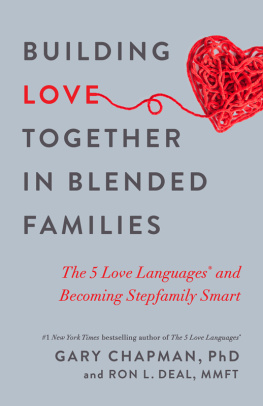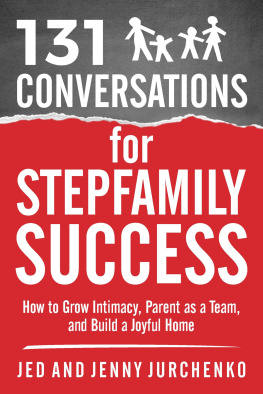Stepfamilies:
History, Research, and Policy
Stepfamilies:
History, Research,
and Policy
Irene Levin
Marvin B. Sussman
Editors
Stepfamilies: History, Research, and Policy has also been published as Marriage & Family Review, Volume 26, Numbers 1/2 and 3/4 1997.
1997 by The Haworth Press, Inc. All rights reserved. No part of this work may be reproduced or utilized in any form or by any means, electronic or mechanical, including photocopying, microfilm and recording, or by any information storage and retrieval system, without permission in writing from the publisher. Printed in the United States of America.
The development, preparation, and publication of this work has been undertaken with great care. However, the publisher, employees, editors, and agents of The Haworth Press and all imprints of The Haworth Press, Inc., including The Haworth Medical Press and The Pharmaceutical Products Press, are not responsible for any errors contained herein or for consequences that may ensue from use of materials or information contained in this work. Opinions expressed by the author(s) are not necessarily those of The Haworth Press, Inc.
The Haworth Press, Inc., 10 Alice Street, Binghamton, NY 13904-1580 USA
Cover design by Thomas J. Mayshock Jr.
Library of Congress Cataloging-in-Publication Data
Stepfamilies: history, research, and policy / Irene Levin, Marvin B. Sussman, editors.
p. cm.(The Marriage & family review series)
Has also been published as Marriage & family review, volume 26, numbers 1/2 and 3/4 1997T.p. verso.
Includes bibliographical references and index.
ISBN 0-7890-0337-6 (alk. paper).ISBN 0-7890-0338-4 (alk. paper)
1. Stepfamilies. I. Levin, Irene. II. Sussman, Marvin B. III. Marriage & family review.
IV. Series.
HQ759.92.S7 1997
306.85dc21 97-39585
CIP
ABOUT THE EDITORS
Irene Levin, PhD, is Associate Professor in the Graduate School of Social Work and Social Research at Oslo College in Oslo, Norway. She is the author of three books, Stepfamilies: Variations and Manifold, To Understand Everyday Life with a Symbolic Interactionistic Perspective, and Relations, all of which were published in Norwegian. She has also written a number of book chapters and articles for national and international publications. Before beginning family research in the early 1980s, she worked as a family therapist for several years. In 1988, she became the first alumna of Bryn Mawr College invited to give the prestigious annual memorial Anita Lichtenstein Lecture. In 1991, she organized the XXVI international seminar of the Committee on Family Research in Norway on the theme of What Is Family? A book review editor for many years, Dr. Levin is a member of several professional national and international organizations and a board member of several professional journals.
Marvin B. Sussman, PhD, is UNIDEL Professor of Human Behavior Emeritus at the College of Human Resources at the University of Delaware. He is also a member of the CORE Faculty of the Union Graduate School of Union Institute in Cincinnati, Ohio. A member of many professional organizations, he received the 1980 Ernest W. Burgess Award of the National Council on Family Relations. In 1983, Dr. Sussman was elected to the prestigious Academy of Groves for scholarly contributions to the field, and, in 1984, he was awarded a lifelong membership for services to the Groves Conference on Marriage and the Family. A recipient of the Distinguished Family Award of the Society for the Study of Social Problems (SSSP), he was honored with the Lee Founders Award, the SSSPs highest professional award, in 1992. The author or editor of 30 books and more than 220 articles on family, community, rehabilitation, health and aging, and organizational transformation, Dr. Sussmans contributions to research and education in the family and aging fields were recognized in 1992 with the State of Delaware Gerontological Society Award.
Stepfamilies:
History, Research, and Policy
CONTENTS
Marvin B. Sussman
Irene Levin
Roderick Phillips
Marilyn Ihinger-Tallman
Kay Pasley
Susan J, Gamache
Jan Trost
Lawrence H. Ganong
Marilyn Coleman
Marilyn Coleman
Lawrence H. Ganong
Irene Levin
Aino Ritala-Koskinen
Anne C. Bernstein
Irene Levin
Emily B. Visher
John S. Visher
Kay Pasley
Jean Giles-Sims
Margaret M. Mahoney
Mark A. Fine
Erica De Ath
Robert Hughes, Jr.
Jennifer D. Schroeder
Pauline-Irit Erera
Marvin B. Sussman
Irene Levin
What can editors say about a volume on stepfamilies which has not already been said by the contributors in the pages that follow? Not too much. Editors have the prerogative to be redundant, praiseworthy, scandalous and obstinate in words and deeds. After all, editors are in control of the process. Yet negativism which is the forte of the majority of editors (such a grandiose statement will get me in trouble) escapes a few. Here authors are honored for their contributions to the body of knowledge; taking advantage of the constructive criticism of reviewers and consequently improving their papers immensely; their tolerance of the complexities and vagaries of publishing. Yes, it is to be published in 1997definitely.
There are a few features in this collection which are notable and require a brief discussion. Eight of the 18 papers are authored by international scholars. This means that perceptions of reality may vary widely since respective writers conceptualize their research within the context of their cultural identities, particularistic training and experiences in their societies. Collaborative work in recent decades has reduced the impact of this cultural specificity. A paradigm of intercultural and interdisciplinary thought and process is beginning to emerge. Marker variables such as agreed definitions of varied forms of families and social class are becoming standardized and used increasingly in national and cross-national studies. Yet one cannot erase the cultural imprinting that is a consequence of professional socialization in the early years of the authors career.
The incidence and prevalence of stepfamilies is increasing in all societies paralleling the increases in the divorce and separation rates. Normalization of stepfamilies is likely to occur as it has in relation to divorce. The phenomenon of stepfamilies is increasing sufficiently to be internalized as less than an extraordinary family form. Before divorce became so prevalent, it was treated as a rare and startling event where the participants were often stigmatized and given the message that they were failures as human beings.
As the divorce rates increased it became an almost everyday activity, a terrible experience for many involved in separation and divorce, but with lessened stigmata, viewed as a situation undesirable and in some instances unhealthy but not an unusual event.
The creation of a stepfamily usually as a consequence of divorce is becoming less of a pathological event as its incidence increases. Learning that a family has stepchildren does not create any strong reaction or rejection. Discovering that the Jones family is one that has stepchildren and stepparents, does not unleash rhetoric which claims that this state of being is less fulfilling when compared to non-stepfamilies.








